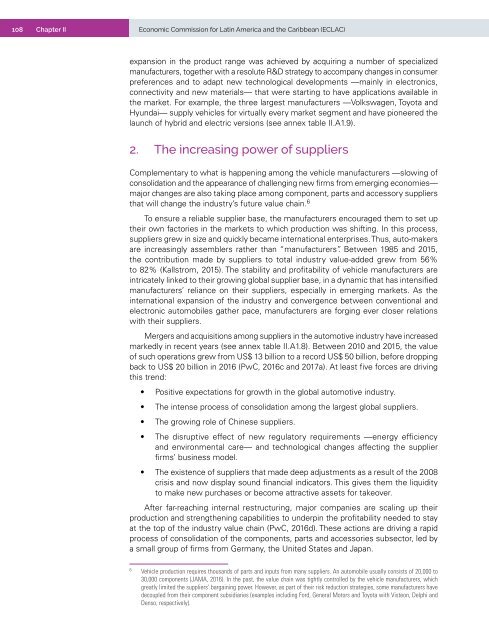Foreign Direct Investment in Latin America and the Caribbean 2017
This publication sets out and analyses the main foreign direct investment (FDI) trends in the countries of Latin America and the Caribbean. The 2017 edition shows that the region is at a difficult juncture. FDI inflows declined by 7.9% in 2016, to US$ 167.043 billion, representing a cumulative fall of 17.0% since the peak in 2011. The fall in commodity prices continues to affect investments in natural resources, sluggish economic growth in several countries has slowed the flow of market-seeking capital, and the global backdrop of technological sophistication and expansion of the digital economy has concentrated transnational investments in developed economies.
This publication sets out and analyses the main foreign direct investment (FDI) trends in the countries of Latin America and the Caribbean. The 2017 edition shows that the region is at a difficult juncture. FDI inflows declined by 7.9% in 2016, to US$ 167.043 billion, representing a cumulative fall of 17.0% since the peak in 2011. The fall in commodity prices continues to affect investments in natural resources, sluggish economic growth in several countries has slowed the flow of market-seeking capital, and the global backdrop of technological sophistication and expansion of the digital economy has concentrated transnational investments in developed economies.
Create successful ePaper yourself
Turn your PDF publications into a flip-book with our unique Google optimized e-Paper software.
108 Chapter II Economic Commission for Lat<strong>in</strong> <strong>America</strong> <strong>and</strong> <strong>the</strong> <strong>Caribbean</strong> (ECLAC)<br />
expansion <strong>in</strong> <strong>the</strong> product range was achieved by acquir<strong>in</strong>g a number of specialized<br />
manufacturers, toge<strong>the</strong>r with a resolute R&D strategy to accompany changes <strong>in</strong> consumer<br />
preferences <strong>and</strong> to adapt new technological developments —ma<strong>in</strong>ly <strong>in</strong> electronics,<br />
connectivity <strong>and</strong> new materials— that were start<strong>in</strong>g to have applications available <strong>in</strong><br />
<strong>the</strong> market. For example, <strong>the</strong> three largest manufacturers —Volkswagen, Toyota <strong>and</strong><br />
Hyundai— supply vehicles for virtually every market segment <strong>and</strong> have pioneered <strong>the</strong><br />
launch of hybrid <strong>and</strong> electric versions (see annex table II.A1.9).<br />
2. The <strong>in</strong>creas<strong>in</strong>g power of suppliers<br />
Complementary to what is happen<strong>in</strong>g among <strong>the</strong> vehicle manufacturers —slow<strong>in</strong>g of<br />
consolidation <strong>and</strong> <strong>the</strong> appearance of challeng<strong>in</strong>g new firms from emerg<strong>in</strong>g economies—<br />
major changes are also tak<strong>in</strong>g place among component, parts <strong>and</strong> accessory suppliers<br />
that will change <strong>the</strong> <strong>in</strong>dustry’s future value cha<strong>in</strong>. 6<br />
To ensure a reliable supplier base, <strong>the</strong> manufacturers encouraged <strong>the</strong>m to set up<br />
<strong>the</strong>ir own factories <strong>in</strong> <strong>the</strong> markets to which production was shift<strong>in</strong>g. In this process,<br />
suppliers grew <strong>in</strong> size <strong>and</strong> quickly became <strong>in</strong>ternational enterprises. Thus, auto-makers<br />
are <strong>in</strong>creas<strong>in</strong>gly assemblers ra<strong>the</strong>r than “manufacturers”. Between 1985 <strong>and</strong> 2015,<br />
<strong>the</strong> contribution made by suppliers to total <strong>in</strong>dustry value-added grew from 56%<br />
to 82% (Kallstrom, 2015). The stability <strong>and</strong> profitability of vehicle manufacturers are<br />
<strong>in</strong>tricately l<strong>in</strong>ked to <strong>the</strong>ir grow<strong>in</strong>g global supplier base, <strong>in</strong> a dynamic that has <strong>in</strong>tensified<br />
manufacturers’ reliance on <strong>the</strong>ir suppliers, especially <strong>in</strong> emerg<strong>in</strong>g markets. As <strong>the</strong><br />
<strong>in</strong>ternational expansion of <strong>the</strong> <strong>in</strong>dustry <strong>and</strong> convergence between conventional <strong>and</strong><br />
electronic automobiles ga<strong>the</strong>r pace, manufacturers are forg<strong>in</strong>g ever closer relations<br />
with <strong>the</strong>ir suppliers.<br />
Mergers <strong>and</strong> acquisitions among suppliers <strong>in</strong> <strong>the</strong> automotive <strong>in</strong>dustry have <strong>in</strong>creased<br />
markedly <strong>in</strong> recent years (see annex table II.A1.8). Between 2010 <strong>and</strong> 2015, <strong>the</strong> value<br />
of such operations grew from US$ 13 billion to a record US$ 50 billion, before dropp<strong>in</strong>g<br />
back to US$ 20 billion <strong>in</strong> 2016 (PwC, 2016c <strong>and</strong> <strong>2017</strong>a). At least five forces are driv<strong>in</strong>g<br />
this trend:<br />
• Positive expectations for growth <strong>in</strong> <strong>the</strong> global automotive <strong>in</strong>dustry.<br />
• The <strong>in</strong>tense process of consolidation among <strong>the</strong> largest global suppliers.<br />
• The grow<strong>in</strong>g role of Ch<strong>in</strong>ese suppliers.<br />
• The disruptive effect of new regulatory requirements —energy efficiency<br />
<strong>and</strong> environmental care— <strong>and</strong> technological changes affect<strong>in</strong>g <strong>the</strong> supplier<br />
firms’ bus<strong>in</strong>ess model.<br />
• The existence of suppliers that made deep adjustments as a result of <strong>the</strong> 2008<br />
crisis <strong>and</strong> now display sound f<strong>in</strong>ancial <strong>in</strong>dicators. This gives <strong>the</strong>m <strong>the</strong> liquidity<br />
to make new purchases or become attractive assets for takeover.<br />
After far-reach<strong>in</strong>g <strong>in</strong>ternal restructur<strong>in</strong>g, major companies are scal<strong>in</strong>g up <strong>the</strong>ir<br />
production <strong>and</strong> streng<strong>the</strong>n<strong>in</strong>g capabilities to underp<strong>in</strong> <strong>the</strong> profitability needed to stay<br />
at <strong>the</strong> top of <strong>the</strong> <strong>in</strong>dustry value cha<strong>in</strong> (PwC, 2016d). These actions are driv<strong>in</strong>g a rapid<br />
process of consolidation of <strong>the</strong> components, parts <strong>and</strong> accessories subsector, led by<br />
a small group of firms from Germany, <strong>the</strong> United States <strong>and</strong> Japan.<br />
6<br />
Vehicle production requires thous<strong>and</strong>s of parts <strong>and</strong> <strong>in</strong>puts from many suppliers. An automobile usually consists of 20,000 to<br />
30,000 components (JAMA, 2016). In <strong>the</strong> past, <strong>the</strong> value cha<strong>in</strong> was tightly controlled by <strong>the</strong> vehicle manufacturers, which<br />
greatly limited <strong>the</strong> suppliers’ barga<strong>in</strong><strong>in</strong>g power. However, as part of <strong>the</strong>ir risk reduction strategies, some manufacturers have<br />
decoupled from <strong>the</strong>ir component subsidiaries (examples <strong>in</strong>clud<strong>in</strong>g Ford, General Motors <strong>and</strong> Toyota with Visteon, Delphi <strong>and</strong><br />
Denso, respectively).


















